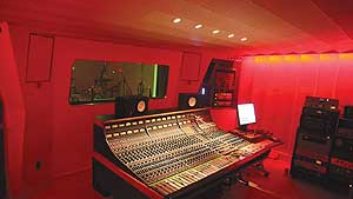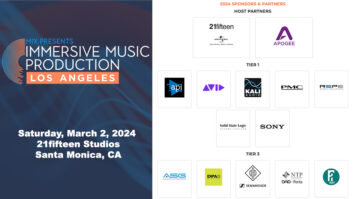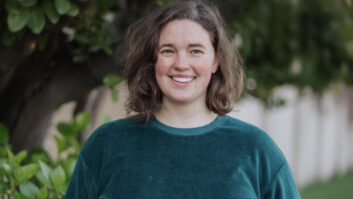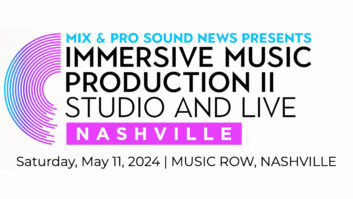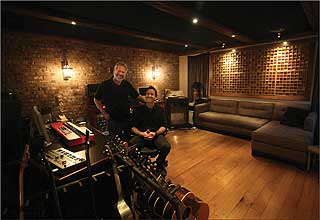
Since founding Sherman Oaks-based Kaufman and Associates in 2005, renowned studio designer Jay Kaufman has designed and built a number of commercially owned studios — including The Bridge, a film-scoring stage about to fire up in Glendale. But during the past couple of years, an increasing number of the projects he’s taken on have been of the home-studio variety.
Studio designer Jay Kaufman (left) in the home studio he designer for writer/producer Adam Watts (right) and Andy Dodd
“We’ve been fortunate in that most clients have been recognizable music producers and/or artists whose level of industry success justifies their demand for a top-quality result,” Kaufman says of his home-studio work. “This has allowed us to design and build some pretty impressive spaces for them.”
In recent months, these rooms have ranged from the relatively compact to the downright palatial. In the former category is a 1,200-square-foot setup he put together for writer/producers Adam Watts and Andy Dodd behind Watt’s residence in Brea. The stand-alone building is now divided into a control room (outfitted with Pro Tools HD6 and such frequently used pieces as a Neve 1073, Avalon VT-737 and Manley Massive Passive, along with Neumann TLM 103 and U47 mics), a live room and a separate writing suite.
“They wanted a comfortable, warm space that worked for their style of writing and recording,” Kaufman explains. “I made extensive use of wood, brick and earth-toned fabrics, along with elegant lighting to provide the ambient feel they were looking for. Of course, the acoustic performance exceeds their expectations, as well.”
At the other extreme is Marco Beltrami’s just-completed facility, which takes the notion of the home studio to an opulent extreme. The stand-alone, 4,600-square-foot building housing the composer’s private scoring stage and separate writing studio is perched atop a mountain in Malibu overlooking the Pacific Ocean, a couple hundred feet away from his new home.
“I was brought into this project by engineer John Kurlander to take care of the acoustic needs of the space,” says Kaufman. “We made significant changes to their original plans to improve isolation and acoustical performance. The main stage is designed to handle up to 30 players, and since their work is almost exclusively for film scoring, John wanted the control room to be more consistent with a theatrical dubbing stage rather than a typical music studio control room.”
The D-Command-centered control room is set up with 5.1 monitoring employing Meyer Acheron 3-channel screen speakers, with the front channels behind a micro-perf projection screen. There are windows everywhere to take advantage of the breathtaking views, “but that provided its own set of acoustic challenges,” Kaufman points out. Beltrami expects to start creating scores in his dream studio later this year.
The job he did for John Mayer and his engineer Chad Franscoviak also posed a unique set of challenges. Early in 2009, Kaufman met Franscoviak at a secluded estate in Hidden Hills. Mayer had leased the place for a year specifically to record significant portions of his most recent album, Battle Studies, while also living there to get the jump on any idea that might come to him along the way. But before that could happen, a great deal had to be done.
“We walked around the 10,000 square feet, and I gave my impressions as to how to make it happen,” Kaufman recalls. “We talked about the best place for the control room, the drum room and the perfect spot for John to cut vocals and guitars. We also began discussing details regarding HVAC and electrical isolation. Then he posed the particular challenge of this project: The installation must not only yield a great-sounding result, it also had to be designed so that all the acoustic treatments — isolation, trapping and so on — were erected in a manner that would not be destructive to the house, so that at the end of the project, the restoration costs would be minimal.”
Franscoviak’s control room comfortably housed Mayer’s Neve 8014 console (heavily modified by Pat Schneider) and the impressive array of vintage and modern outboard gear the artist had accumulated since he hit pay dirt with the 2001 breakthrough album, Room for Squares. One room was dedicated solely to housing his 160 guitars.
“The space was sonically accurate with the big monitors Chad and John are accustomed to,” Kaufman points out, “with the added bonus of two large picture windows looking out into the backyard garden. In a number of spots, we hung heavy drapes, with a mass-loaded vinyl liner for isolation. By opening or closing the drapes, you could control the reverberant field within the drum room.
“We pulled it off on schedule for their timeline,” he continues, “and did it all with finish materials that complemented the existing décor yet created the vibe they were looking for.”
What all three projects had in common was Kaufman’s methodology. “When I first get involved with a project, whether a home studio or commercial space, the process begins the same way,” he explains. “It’s critical to sit down and discuss what the clients’ expectations are for the studio, what they do specifically and how they work. With this information in hand, I start developing a plan. If it’s an existing space, I look at it from all angles and determine if it will meet our criteria. If not, we move on and look for alternative spaces.”
Thanks in no small part to Kaufman’s ground-breaking work, home studios have evolved exponentially over the last 20 years, and the best of them rival the best commercial spaces. “To a large degree,” says Kaufman, “these advances are a by-product of technology, but excellent equipment is still brought to its knees in a poorly designed acoustic space.”
Next up for Kaufman are home-studio projects for Johnny Mead from the band Radford and for composer Danny Elfman.
Send L.A. news to Bud Scoppa at
[email protected].

